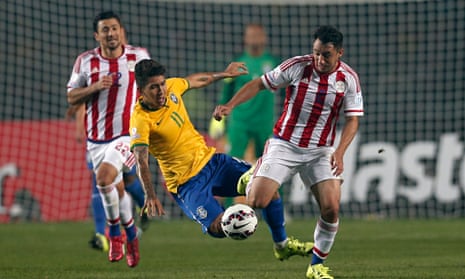For football’s flushest clubs, there are some intriguing prospects invitingly available this window, with one notable exception. If a striker is what you need – and without even looking too far afield all of the Premier League’s top four could do with any world-class finishers who happened to make themselves available – the search is a tricky one.
It is still early days in this transfer period but the most eye-catching deals ( Arda Turan, Geoffrey Kondogbia, Petr Cech, Sami Khedira) and the grandest names being heavily touted by their representatives (Paul Pogba, Arturo Vidal, Sergio Ramos, David de Gea etc) are more loved for their qualities further back on the pitch. At the sharp end? The pool does not exactly overflow.
When Napoli’s loquacious president, Aurelio De Laurentiis, reiterated his valuation of Gonzalo Higuaín – just a mere nudge over £67m – it smacked of glorious brinkmanship. “If a madman arrives and offers to pay his buyout clause then we must consider it,” he said but it also shone a light on to the state of supply and demand with strikers.
Higuaín has great pedigree, having led the line and scored roughly a goal every other game during his career with River Plate, Real Madrid, Napoli and Argentina. He joined the Serie A club for a shade over £30m two years ago. De Laurentiis knows there are willing buyers, without great alternatives on the market, so he can push the price up accordingly. Now aged 27, if anyone takes the Higuaín plunge they probably won’t get a great deal of resale value.
The same goes for Jackson Martínez, aged 29, who has joined Atlético Madrid for a fee in the £25m bracket. He replaces Mario Mandzukic (also 29) who left for Juventus. Carlos Bacca, aged 28, has moved to Milan from Sevilla for his buyout clause of £21m. They are all proven, experienced European performers. The fact their statistics pale in comparison with the phenomena at Barcelona and Real Madrid is one of those things. They are, in terms of availability and readiness at a high level, more or less the next best thing.
Midway through last season, Arsène Wenger observed there are not enough predators emerging outside of South America. “If we look across the world of football, then South America is the only continent to develop strikers today,” he said, estimating that “at least 80%” of the best attackers come from South America. Wenger enthused about the fighting qualities and determined self expression that are still part of the picture for young players in that region.
So following that train of thought, it is slightly alarming to look at how the strikers fared in the Copa América. It was not a great tournament for forwards. The top scorers were Paolo Guerrero, of Peru, and Eduardo Vargas, of Chile, who managed only four goals. Vargas struggled to find any rhythm and largely played out of position for QPR last season – that was the 25-year-old’s third loan since he joined Napoli, who seem conspicuously keen to get him off the books.
One goal behind was Sergio Agüero, Paraguay’s Lucas Barrios and Vidal, of Chile. Guerrero and Barrios are both in their 30s and fairly well travelled, now back playing in South America, so their European days would appear to be over. Guerrero is a traditional striker who played well in the Copa but his history of disciplinary explosions would make him a gamble for most suitors. He has just joined Flamengo, the club from Rio de Janeiro.
Looking more broadly around South America, Argentina remain the best served, with Agüero, Higuaín and of course Lionel Messi at their disposal. Colombia also have a decent crop, with Bacca and Martínez, although they do not always get used to the best effect because of the desire to shoehorn an off-form Radamel Falcao into the team.
It will be interesting to observe where all this leaves a few big hitters in the Premier League. Chelsea delivered brilliantly last summer with their purchase of Diego Costa. Now, with Didier Drogba’s departure, they have signed Falcao but whether he is the answer remains to be seen.
Manchester City, with Edin Dzeko perhaps on his way out and Stevan Jovetic disappointing in the goals stakes, would welcome an accomplice for Agüero. Arsenal have the shadow of the is-Giroud-good-enough debate sparked by Thierry Henry. Manchester United may wish for a post-Falcao option.
Tottenham could do with an alternative to Harry Kane able to provide more than Roberto Soldado or Emmanuel Adebayor. Liverpool might not have finished their forward business despite already investing in Danny Ings and Roberto Firmino. Even just mentioning the top handful in England, there are not really enough high quality strikers to go around.
Juventus spent quite heavily in Paulo Dybala from Palermo, an Argentinian who, at 21, has potential to refine his talent. So who else is buyable? Is Lyon’s Alexandre Lacazette, another lively prospect, the answer? If he is, perhaps the question needs to be, where on earth are all the rest of the planet’s emerging, potentially great strikers?

Comments (…)
Sign in or create your Guardian account to join the discussion